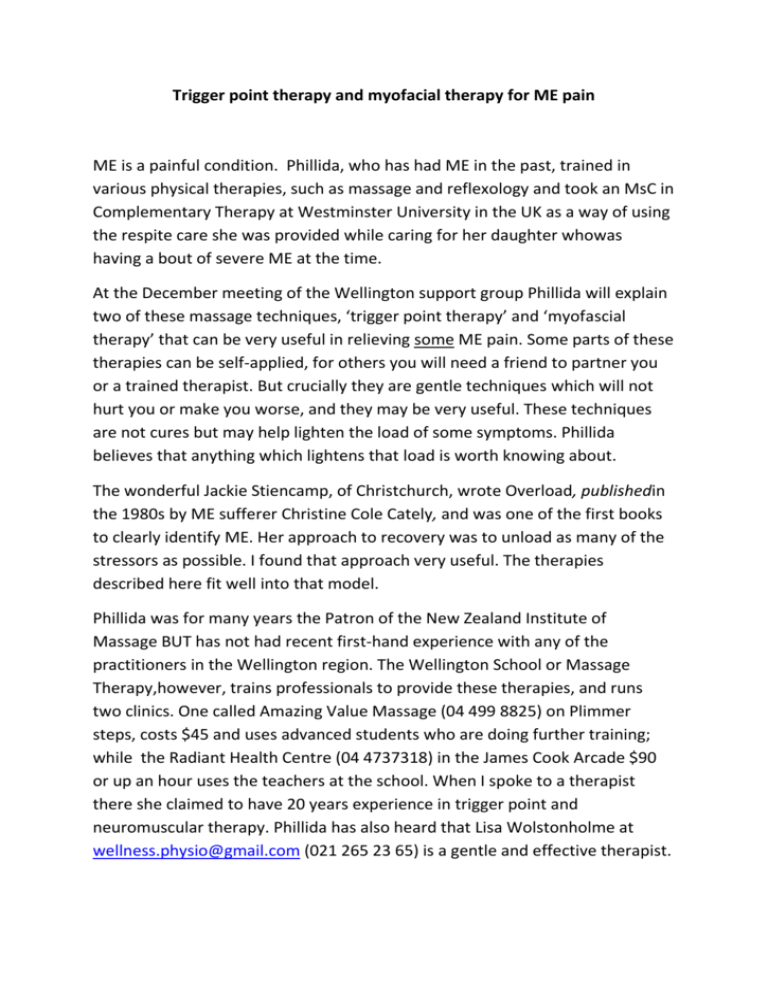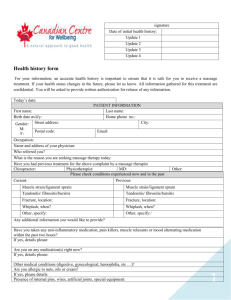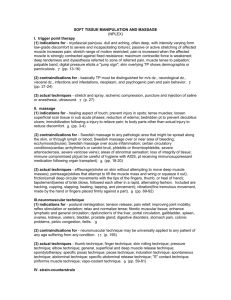Trigger point therapy - WellMe || Wellington Region ME/CFS Support
advertisement

Trigger point therapy and myofacial therapy for ME pain ME is a painful condition. Phillida, who has had ME in the past, trained in various physical therapies, such as massage and reflexology and took an MsC in Complementary Therapy at Westminster University in the UK as a way of using the respite care she was provided while caring for her daughter whowas having a bout of severe ME at the time. At the December meeting of the Wellington support group Phillida will explain two of these massage techniques, ‘trigger point therapy’ and ‘myofascial therapy’ that can be very useful in relieving some ME pain. Some parts of these therapies can be self-applied, for others you will need a friend to partner you or a trained therapist. But crucially they are gentle techniques which will not hurt you or make you worse, and they may be very useful. These techniques are not cures but may help lighten the load of some symptoms. Phillida believes that anything which lightens that load is worth knowing about. The wonderful Jackie Stiencamp, of Christchurch, wrote Overload, publishedin the 1980s by ME sufferer Christine Cole Cately, and was one of the first books to clearly identify ME. Her approach to recovery was to unload as many of the stressors as possible. I found that approach very useful. The therapies described here fit well into that model. Phillida was for many years the Patron of the New Zealand Institute of Massage BUT has not had recent first-hand experience with any of the practitioners in the Wellington region. The Wellington School or Massage Therapy,however, trains professionals to provide these therapies, and runs two clinics. One called Amazing Value Massage (04 499 8825) on Plimmer steps, costs $45 and uses advanced students who are doing further training; while the Radiant Health Centre (04 4737318) in the James Cook Arcade $90 or up an hour uses the teachers at the school. When I spoke to a therapist there she claimed to have 20 years experience in trigger point and neuromuscular therapy. Phillida has also heard that Lisa Wolstonholme at wellness.physio@gmail.com (021 265 23 65) is a gentle and effective therapist. If you are unable to access suitable practitioners you may find Bowen or Qigong useful as these use a similar gentle techniques and are applicable to the facia. BUT since Phillida has not tried these services she cannot recommend them personally and suggests it would be good to share any information members might have about availability and quality in the region. Trigger point therapy (Sometimesa slightly more complex version is called neuro-muscular therapy) Trigger points are tender spots which can develop in any muscle, especially if the muscle is inactive or under prolonged tension.There are characteristic patterns where these points develop. There is about an 80% overlap with the Ar-Chi points in acupuncture; and fibromyalgia is defined as tenderness in a majority of 18 symmetrical pairs of tender points at specific locations around the body. Common locations for trigger points are the neck or shoulder but it is important to note that they can develop in any muscle, including in your internal muscles. Identifying trigger points: 1. Running your finger along a muscle fibre you may feel a tight knot, possibly as big as a pea, but possibly more like a ‘taut guitar string’, depending on the size of the muscle fibres affected. 2. Pressing on the spot will feel sore and produce a pattern of pain which is familiar. 3. This referred pain may radiate from that spot or maybe distant from it. 4. The pain may ‘sensitize’ your nerves creating horrible pain such as headaches or making you feel nauseated or over sensitive to light or other sensory stimulation. The aim of therapy is to release these knots by restoring blood flow through the knot and allow the muscle to regain its ‘normal’ resting length; this will release both the muscle and the associated nerve pain. The Theory: how trigger points develop. Muscles are designed to move. To facilitate movement each muscle fibre has rows of little, evenly spaced, cells that are like air bags which change shape as the muscle contracts and elongates. These are called sarcomeres. These bunch up at the centre of contracted muscles and stretch out towards to ends, called insertion points. Trigger points develop when these bunched up cells do not release and return to their normal resting length and therefore an even arrangement along the muscle fibre. The pain is likely to be worse towards the centre of the muscle, but the stretched out ends and insertions points may be sore too. As the muscle works it uses nutriments in the blood supply and creates waste by-products which are carried away by the blood flow. The oxygen carried in the blood is central to this process. If normal healthy people do unusual amounts of exercise they may create waste products more quickly than they can be carried away. They will then feel stiff and sore. If you do gentle exercise the next day or have a massage or a hot bath to stimulate the blood flow, the stiffness will dissipate. With ME, however, there is a well-established oxygen deficit and often a reduced blood volume and blood flow as well. You are not able to use your muscles much and the waste by-products of contracted, stressed muscles are not carried away. This is greatly enhanced by the bunching up of the sarcomeres which restrict blood flow further and metabolic wastes therefore build up. The sarcomeres bunch up especially around the middle or fattest ‘belly’ part of the muscle. This happens to be where the nerve which controls the movement of the muscle usually enters and leaves the muscle. As the waste products build up they restrict the oxygen supply still further and the restriction creates bunched up ‘knots’ of tissue and further over-stimulates the nerves producing the horrible ‘neural sensitisation’ effect. This may well be enhanced as the pain leads to ‘breath holding’ which is very shallow up-tight breathing. You cannot get enough oxygen with your shoulders hunched up against pain, and the knots my well form in the muscles you use for breathing too. Breath re-education can be a very helpful adjunct to this therapy. Therapy You cannot just relax these knots, they need to have the blood supply restored. This can be done by mechanical manipulation, but although you probably try and ease the feeling by rubbing along or across the muscle, this is unlikely to be sufficiently effective. The best way is to use A PRESSURE AND RELEASE ACTION to pump the blood through the knot of the tender point. There are a number of therapies which do some version of this. ‘Point holding’ is one, acupressure can help, and so can anacupuncture technique called ‘superficial dry needling’, saline injections into the tender point are also claimed to be beneficial ( this technique is currently offered by a Wellington pain specialist working at Southern Cross Hospital, Newton).But these techniques have to be spot-onaccurate in order to be effective. These techniques aretherefore likely to be less effective than the method described below. 1. Identify the tender point. Run a finger along the length of the muscle and find the sore spot. 2. Press on it, possibly at a slight angle. As you press on it you will feel a kind of nice/nasty pain with a familiar pattern of referred pain. (A really experienced therapist will be able to identify the tender spot from your description of the referred pain pattern, but the books which show common pain pattern maps of the body are also useful.) 3. Press into the knot to a count of 8, 4. Release for a count of 2, 5. Continue this action until you get a marked change of sensation. You will not hurt yourself by repeating this action. 6. If you want to, rest for maybe 10 seconds to half a minute and repeat. 7. You will not harm yourself by repeating this process. Repeat until you get a result, but if you are on the spot you should get quite a quick response. But go gently at first. Professional therapists will then 1. Bring the two ends of the muscle towards each other so that the muscle goes slack and is not stretched, for about 20 seconds. They do this to make the most of the contraction and release response which accompanies muscle movement. 2. They will then gently stretch the ends of the muscle apart to move it towards its ‘normal resting length. Once this has occurred blood flow will be restored and the pain will stay away until the bunching and buildup of waste products occurs again. Unfortunately you cannot do this bit for yourself as it has to be done passively because your voluntary movement will put tension back into the contracting muscle. But the pumping action will be useful and you can control it yourself. Risks 1. The main risk is overdoing it. Remember that it takes energy and oxygen to clear these blockages. I only do about 5 points to start with and see how you go. I have heard of a young women who got such relief that she urged the therapist to go on and then had a serious crash next day, so, as always, easy does it at first. 2. If you go to a professional therapist you may find getting there and back more than the relief is worth or that they are over enthusiastic to give you the full hour’s treatment. Again limit the time until you know. 3. And, as always you may have to listen to some idiot therapist’s theories. There are some mighty judgemental self-righteous therapists out there. Block your ears if you hit one and pass on the info if you find one who is useful. Resources This therapy is widely used by people with fibromyalgia so there are a number of useful guides and books on the subject. These are just a few. The Arthritis Foundation may have more. David Simons and Janet Travell wrote Myofascial Pain and Dysfunction: the trigger point manual in the 1950s. This was the pioneering publication on the topic and is still the classic. Clair Davies and Amber Davies, The Trigger Point Therapy Workbook: Your selfhelp treatment for pain relief, (New Harbingern2004) is clear and has good guide to locating points and self-treatment. It was written by two people who cured themselves of chronic pain (they didn’t have ME) and then trained as therapists. Valerie DeLaune, Trigger Point Therapy for headaches and migraines: your selfhelp Treatment work book for pain relief, (Oakland Ca. New Harbinger 2004) has very good illustrations of common referred pain patterns relating to the head and neck. Donna Finando: “Trigger Point Self-Care Manual”, (Rochester Vermont, Healing Arts Press, 2005).This does show various ways of reaching hard to reach points on you own. Simeon Niel-Asher: “The Concise Book of Trigger Points”, (Chichester, Lotus Publishing, 2006).Very good on the location of common trigger points and their associated pain patterns. Leon Chaitow, Modern Neuromuscular Techniques, (Churchill Livingstone, 2003 first published in 1996) is rather complex for self-help but has an excellent CD clearly demonstrating his treatments which a willing person could copy. Chaitow is the ultimate osteopath, an enthusiast for complementary therapy; he trained many therapists at Westminster University in the UK. Leon Chaitow: Positional Release Techniques, London, Churchill Livingstone, 2007. This is another Chaitow text book; it is not well written butdevelops the technique further. It has a good CD showing the use of these techniques. (Other aids: Some people use a sort of stick with a knob on it, (a bit like a thing for throwing balls for dogs) to reach difficult sites. There are other aids at www.TriggerPointBook.com which is a commercial site but has OK introductory material.) Tim Parkes, Teach Us to Sit Still (Vintage 2011) may interest you. Tim is a writer who lives in Italy. He does not have ME but did have disabling internal pelvic pain. He could not sit, he couldn’t sleep, and it was excruciating to urinate etc. His search for an answer to this pain is told in a humane and engaging way which you may find sympathetic. The doctors offered all sorts of drastic urological surgery, which he nearly had in desperation.( I know someone who had surgery for this condition and it made it much worse, because the urinary tract itself wasn’t the problem) Tim Parkes has a good chapter on the ‘promiscuity’ of the internet where so many people offer promised cures, along with bogus testimonials motivated largely by having something to sell. It is best to take your cues from patient controlled sites such as www.healthrising or similar. However while looking for an explanationhe came across a book called a ‘Headache in the Pelvis’ by two Californian therapists and recognised himself (David Wise and Rodney Anderson, Popular Medicines and Health National Centre for Pelvic Pain Research 2010). They suggested that the condition was caused by the development of trigger points in the muscles of the pelvic floor. The treatment they offered was trigger point therapy up the anus. Tim did not fancy flying to California to have an unorthodox ‘treatment’applied to his bowels,but their description fitted his case and answered many questions. So he took up meditation. He practiced the extreme form where you sit still for 10 days (how could he have stood it? Well sat it?) Anyway by learning to really relax he did solve his physical problem, although he got a bit hooked on meditation! The point was that the deep relaxation did help the muscles to ‘let go’ and the knots to release. So it may be that this is why things like Yoga Nedra which increase oxygen and reduce muscle tension can have such helpful benefit for ME. It is also maybe why massage and reflexology can reduce distress at least temporarily too. The web site for Health Rising ( cortrising@gmail.com) has very useful up to date information on oxygen deficit, blood volume restriction etc. Myofacial Therapy Myofacia is a film of, usually, whitish material that covers all our organs. It covers ever muscle fibre and each discrete muscle. It looks like a sort of white cling film which covers kidneys or legs of lamb in the butchers shop. When you try to remove it it turns out to be quite tough. It is extraordinary stuff; its role is to retain the shape of our organs while allowing them to slide over each other at the same time. So it is tough, holds its shape and is flexible all at the same time. It forms a continuous sheet throughout the body, but has a characteristic pattern of ‘trains’ or lines of tension running through it. These tougher trains run up the back of the neck and over the skull and maybe anchored above the eyes in the brow. You can get an idea of these trains by pulling on one corner of a jersey and seeing how the lines of tension fan out. Its structure is something of a mystery but it is possible that it is a semi-solid which can however also develop lumps and knots, and maybe even crystals especially along the trains of tension. If it gets tangled up and knotted it can be really painful. Again the pain can be referred quite away from the site of the tangle. If you have been immobilised then the myofascia may well loose their fluidity and become painful. Therapy Therapy is very gentle and should feel quite pleasant. It consists of a slow stretchy pull generally in the direction of the ‘train’. The warmth of the hand also helps the stretching and easing. You simply hold this pull until the material ‘gives’ slightly and straightens and stretches out. You just wait patiently for this ‘give’ to occur. The person acting as the therapist gently ‘engages’ with the tissue, usually with the ball of the hand or the length of their arm. This should not be painful or hard it is just a ‘holding’. Their role is just to anchor the fascia so that they or the patient can apply a slight slow pull against this anchor. As the tissue softens the sensation will be as if the resistance eases and you are ‘let through’. You then go on to the next bit. It can be done in co-operation with a willing partner providing the anchor, but you may need to guide them and not let them get heavy handed. Risks As above. The risks seem to me to be very low, but the even the gentle pulling action will involve effort and some energy. Therapeutic services The training is post-basic massage training, usually a certificate additional to basic massage training. Resources: Robert Schlep, Thomas Findley, Leon Chaitow et al. al. Fascia: the tensional Network of the Human Body: the science and clinical application in massage and movement therapy, is not well written but will tell you much more about the fascia. Leon Chaitow and Sandy Fritz, A Massage Therapists Guide to understanding, locating and treating myofascial trigger points, Churchill Livingstone, 2000, is a good guide to where the tangles maybe.







